10 Types of Trees in Arizona (With Pictures)
-
Samantha Reed
- Last updated:

When you think of Arizona, the last thing that may come to your mind is the trees. You probably think of the desert, the heat, and the Cardinals team. However, Arizona is one of the ten largest states in the United States and is filled with a wide variety of landscapes—ranging from mountain ranges, plateaus, rivers, and the desert it’s so famous for.
Arizona’s variety of trees extends beyond what you might see in your neighborhoods. Native trees include true desert dwellers in Southern Arizona to pines and firs in the mountains up north. Not only do trees provide shade and shelter during the sweltering summer heat of Arizona, but planting native trees is also an excellent way to contribute to the environment and world you live in. Let’s look at 10 Arizona’s most common trees.
The 10 Common Types of Trees in Arizona
1. Arizona Sycamore
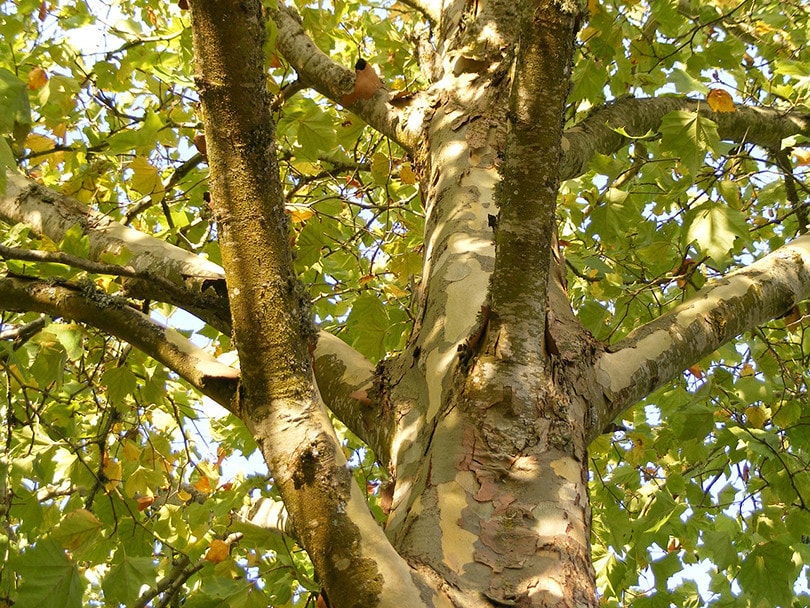
| Other Common Names | Alamo |
| Average Size at Maturity | 36-72 ft tall and 30-55ft wide |
| Flowering Season | March – April |
The Arizona Sycamore, named so because it is so rare in the wild and is only found in specific areas of Arizona, is usually found below 6000 ft. This medium-sized tree has star-shaped leaves and a low, spread open canopy. The leaves have simple groups of three to five lobes, and they are often fuzzy, making for an interesting combination. You can tell the younger Arizona Sycamore trees apart from the older ones due to their gray-ish, green bark. As the trees grow, the bark peels away in areas and displays a white inner layer of bark in the trunk.
Sycamores fare the best in well-drained soil, usually clay, loam, or sand. If your soil is slightly acidic or alkaline, you will also find it easier to grow and maintain an Arizona Sycamore. The roots of the Sycamore tree are great for reducing the effects of erosion since the roots dig into the soil and help bind it together.
2. Ironwood
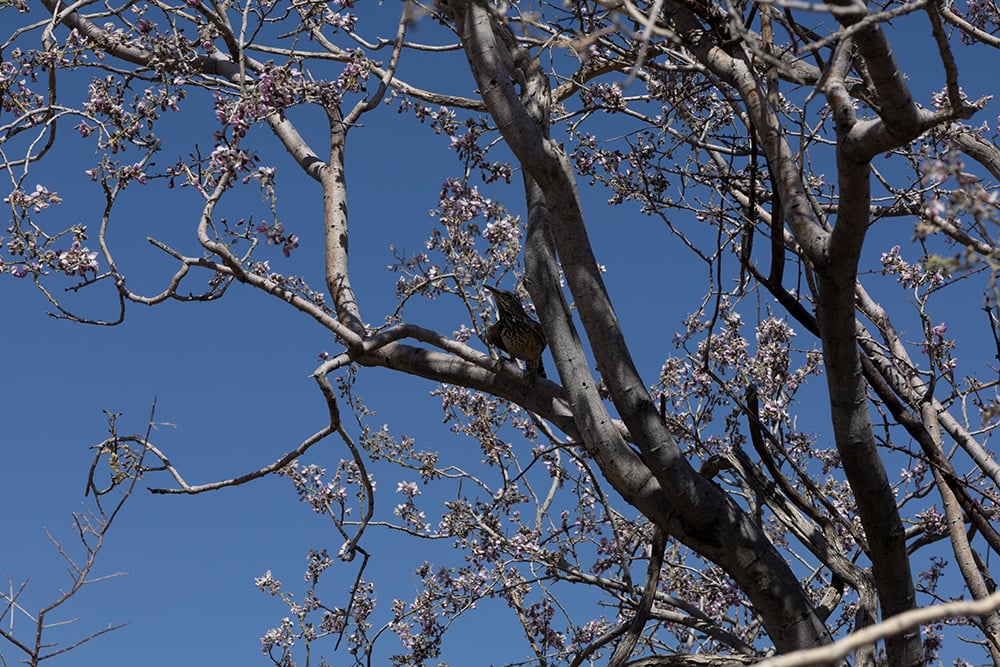
| Other Common Names | Arizona Ironwood, Desert Ironwood |
| Average Size at Maturity | 15-30 ft tall and 15-30 ft wide |
| Flowering Season | Pink flowers in the Spring |
The Ironwood tree is coveted for firewood and woodworking because of its strength. It is native to the Sonoran desert, is extremely hardy, and can tolerate almost any amount of sun and heat. Despite this, long periods of drought or freezing temperatures can cause the tree to shed outer layers for energy conservation. Ironwood trees may be slow-growing, but they produce dense, blush gray leaves that can turn red and purple with flowers during the early summer.
3. Arizona Cypress
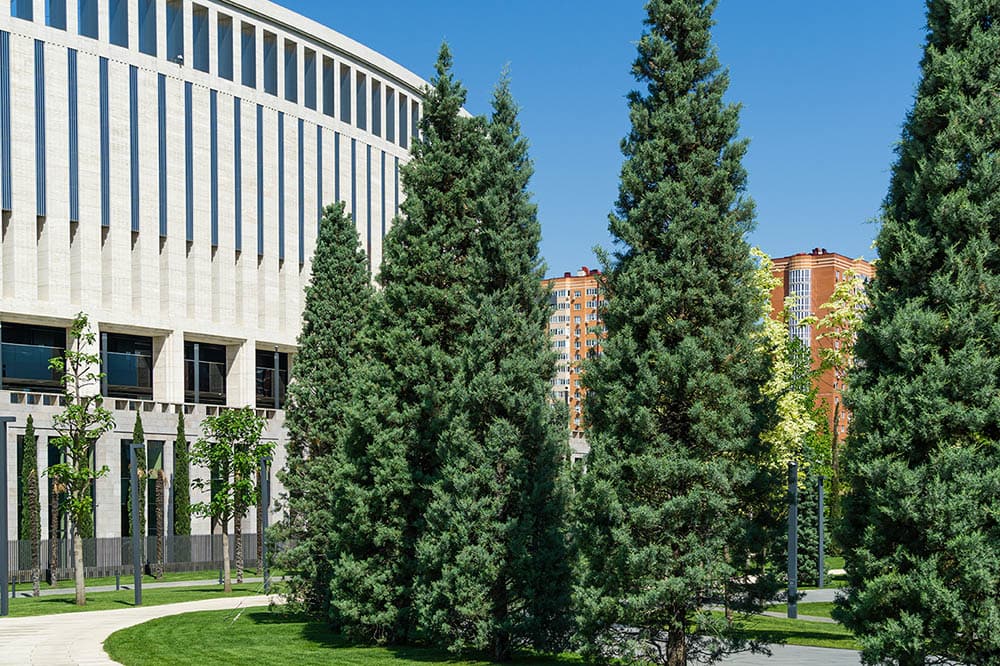
| Other Common Names | Roughbark Cypress |
| Average Size at Maturity | 40-50 ft tall and 25-30 ft wide |
| Flowering Season | No additional flowering |
The Arizona Cypress is native to Western Arizona and is commonly found in regions with elevations of 3,000–6,000 feet. This sturdy tree impedes erosion, serves as a windbreaker, and is ideal for Arizona backyards. Arizona Cypress trees are tolerant to heat and drought, making them perfect for the various landscapes and climates Arizona has to offer. Cypress trees even make excellent Christmas trees!
An Arizona Cypress grows at a moderate pace, adding 1 to 2 feet per year. They grow well in almost any soil and are not sensitive to acidic, neutral, or alkaline soil. The Arizona Cypress tolerates clay, loamy, or even sandy soil as long as the soil drains well. This tree produces small leaves that look like scales, and they come in different shades like gray-green or blue-green.
4. Palo Verde
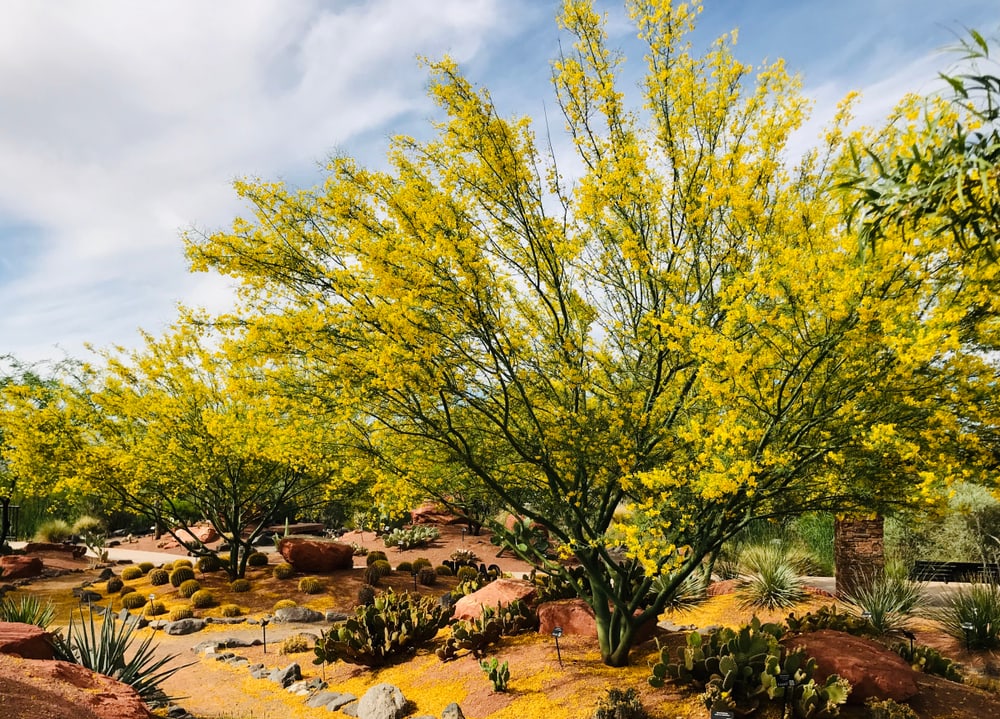
| Other Common Names | Jerusalem Thorn, Jelly Bean Tree |
| Average Size at Maturity | 15-20 ft tall and 20-25 ft wide |
| Flowering Season | Blooms in the warm months after rains |
The Palo Verde is the tree of the desert. Designated as Arizona’s state tree in 1954, the Palo Verde tree can live to be between 100 and 400 years old. This multi-branched and bright green tree paints a stunning picture and is easily identified by its arching branches and bright blooms of yellow and white flowers.
When it blooms during the summer, it floods the landscape with thousands of five-petaled flowers. Palo Verdes can grow in various conditions, and they have unique green bark that allows them to photosynthesize through their bark even in the hottest temperatures.
5. Fremont Cottonwood
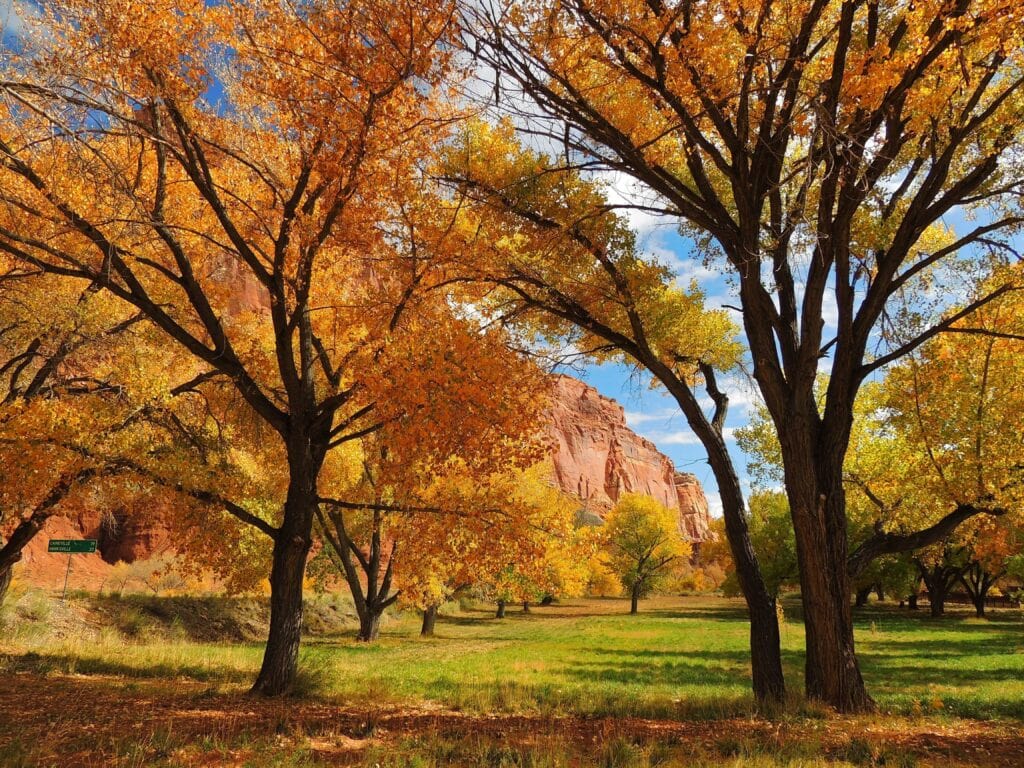
| Other Common Names | Valley Cottonwood |
| Average Size at Maturity | 20-90 ft tall and 30-50 ft wide |
| Flowering Season | March to April |
You can find Fremont Cottonwoods growing in areas near rivers, lakes, and streams in areas with elevations of 4,500 to 6,000 feet. This fast-growing tree is one of the most important plant species to wildlife in riparian areas. Beavers use cottonwood for their dams, and animals like rabbits, deer, and elk feed on the tree’s shoots.
Even in death, over 40 animal species use the hollowed-out trees for nesting. When the Fremont Cottonwood is young, the bark and branches are smooth, but it becomes deeply furrowed with cracks as it ages. The trees are often broader than they are tall, and the leaves are shiny, triangular-shaped, and usually light green.
6. Velvet Mesquite
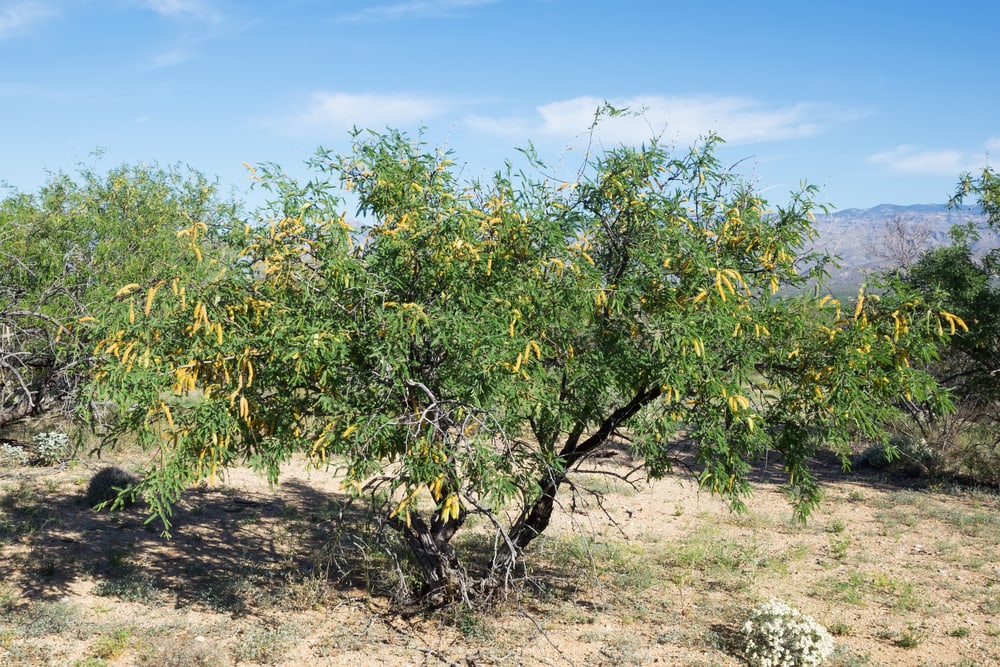
| Other Common Names | Algarrodbo Blanco, White Carob Tree, |
| Average Size at Maturity | 20-30 ft tall and 20-30 ft wide |
| Flowering Season | Spring and summer |
The Velvet Mesquite gets its name from its dark green and velvety leaves. It grows wild along the washes, even forming its own woodlands in foothills around areas like Tucson. Thes hardy trees are known for their extreme drought and heat tolerance, making them well suited to the desert landscape. In addition, the desert beauty is easy to maintain if you plant one on your property. Velvet Mesquite trees are a great choice for anyone who wants a low-maintenance, gorgeous green tree.
7. Arizona Walnut
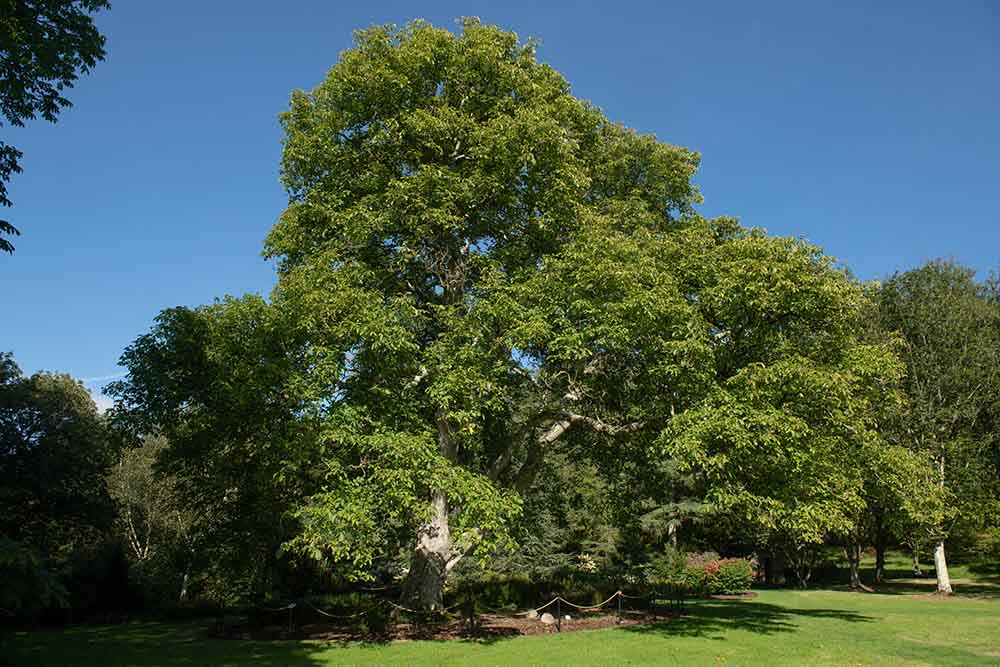
| Other Common Names | Arizona Black Walnut, River Walnut, Mountain Walnut, Nogal Silvestre |
| Average Size at Maturity | 36-48 ft tall and 20-50 ft wide |
| Flowering Season | April to May |
The Arizona Walnut is a deciduous tree that sheds its leaves at the end of the growing season. Arizona Walnut trees have light brown or gray bark, produce delicious walnuts, and can grow up to over 48 ft tall. They are spring plants that prefer growing near dependable water sources, and you cannot plant them in dry, poorly-irrigated soil. In the wild, you can find the trees near Willows, Cottonwoods, and Sycamore trees. Arizona Walnut trees have forked trunks, wide-spreading branches, and a distinct woodsy and citrus scent.
8. Blue Palo Verde

| Other Common Names | Blue Paloverde |
| Average Size at Maturity | 25-30 ft tall and 20-25 ft wide |
| Flowering Season | Begins late March, peaking in Mid-April |
As the state tree for Arizona, the Blue Palo Verde is one of the most popular desert landscape trees. Its small size and blue-green leaves make a striking picture when in bloom. However, for most of the year, its unusual foliage is absent. Palo Verdes are fast growers, and when they bloom, they produce fragrant yellow flowers. It is a great tree to include in your landscape if you want to attract birds to your garden. Blue Palo Verdes can grow up to 25 feet tall and are a highly durable desert species.
9. Rocky Mountain Juniper
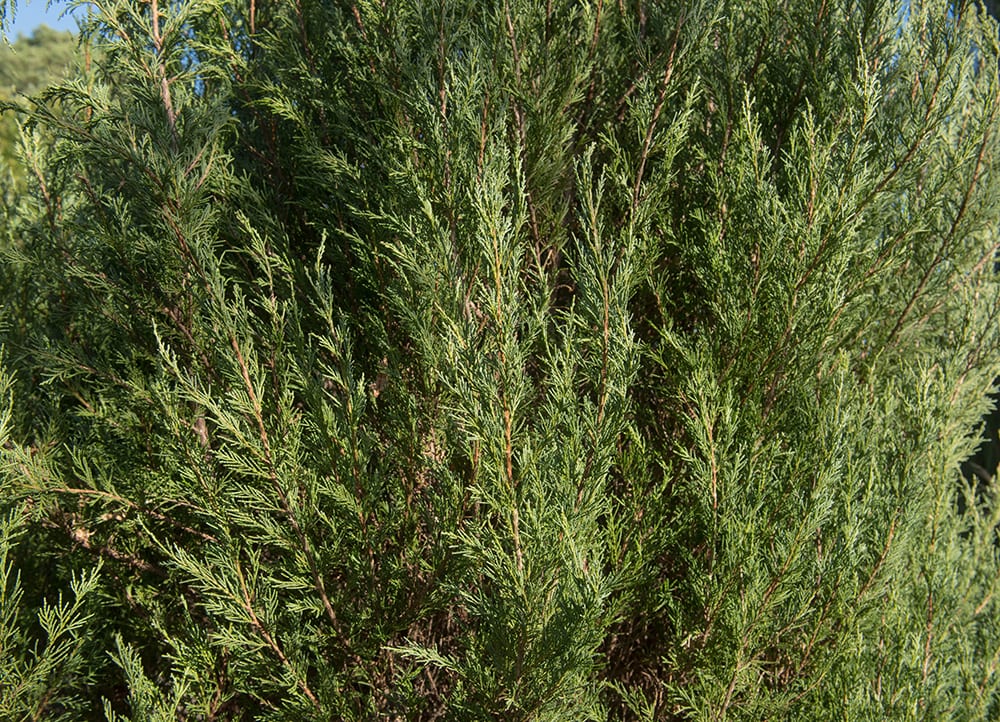
| Other Common Names | Rocky Mountain Red Cedar, Colorado Red Cedar, Western Red Cedar, Western Juniper, River Juniper, Cedro Rojo |
| Average Size at Maturity | 30-40 ft tall and 3-15 ft wide |
| Flowering Season | April to May |
The Rocky Mountain Juniper is native to areas in Arizona above 6,000 feet and can grow 3 to 30 feet tall. It has more of a Christmas tree shape than other Juniper tree species, has dark green to blue-green leaves, and produces berry-like cones. Rocky Mountain Juniper cones have even been used in food, medicine, and even tea and gin! The trees grow well in open bluffs, rocky points, ravines, and canyons.
10. Ponderosa Pine

| Other Common Names | Ponderosa Pine |
| Average Size at Maturity | 60-100 ft tall and 25-30 ft wide |
| Flowering Season | Spring |
Ponderosa Pines grow in areas with elevations of 5,500–8,500 feet. Ponderosa Pines have a dark reddish-brown bark when they’re young that transforms into a russet brown as they get older. The thick bark makes them resistant to wildfires, and they are highly drought-tolerant. However, while they’re hardy trees, Ponderosa Pines can be damaged by late frosts, and they don’t tolerate shade very well.
Conclusion
Arizona’s vast differences in climates, from its mountain landscapes to its arid deserts, hold the potential for an equally vast array of plant life. Planting native trees in Arizona is the easiest way to ensure a successful landscaping adventure, but that doesn’t mean other trees or plants won’t work in your yard.
Arizona natives are well adapted to the desert environments, and most need little to no care once they establish their roots. Whether you live in the valley or the cooler highlands of Arizona, there are so many native species to choose from that your landscape is bound to thrive no matter your location.
Featured Image Credit: LHBLLC, Shutterstock
Contents
